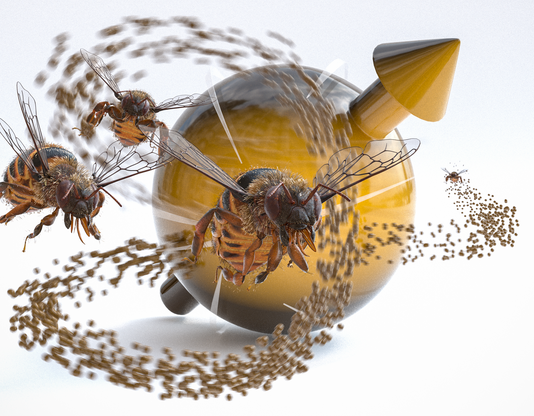At first glance, a 51-ion system may appear to be easy to use. But even if these charged atoms are only changed back and forth between two states, the result is more than two quadrillion (1015) different orderings which the system can take on.
 “Levy flights” describe statistical properties of elementary quantum magnets as well as of bees foraging for food. Image Credit: Christoph Hohmann (MCQST Cluster).
“Levy flights” describe statistical properties of elementary quantum magnets as well as of bees foraging for food. Image Credit: Christoph Hohmann (MCQST Cluster).
As an excitation applied to the system might propagate irregularly, the behavior of such a system is hard to calculate with standard computers. A statistical pattern known as a Lévy Flight governs the excitation.
One characteristic of such motions is that, in addition to the smaller leaps that are expected, much greater jumps are also present. This phenomenon can also be observed in bee flights and unusually violent stock market moves.
Simulating Quantum Dynamics: Traditionally a Difficult Task
While even traditional supercomputers struggle to simulate the dynamics of a complex quantum system, quantum simulators make it look easy. But how can the findings of a quantum simulator be confirmed without being able to undertake the same calculations?
Observations of quantum systems revealed that equations similar to those developed by the Bernoulli brothers to explain fluid flow in the 18th century may be used to capture at least the long-term behavior of such systems.
The authors employed a quantum system that simulates the behavior of quantum magnets to verify their theory. Researchers were able to utilize it to demonstrate that, following an initial phase influenced by quantum-mechanical effects, the system could be represented using fluid dynamics equations.
Furthermore, scientists demonstrated that the same Lévy Flight statistics that explain bee search techniques also apply to quantum fluid-dynamic phenomena.
Captured Ions as a Platform for Controlled Quantum Simulations
The quantum simulator was developed at the Austrian Academy of Sciences’ Institute for Quantum Optics and Quantum Information (IQOQI) on the University of Innsbruck Campus.
Our system effectively simulates a quantum magnet by representing the north and south poles of a molecular magnet using two energy levels of the ions. Our greatest technical advance was the fact that we succeeded in individually addressing each one of the 51 ions individually. As a result we were able to investigate the dynamics of any desired number of initial states, which was necessary in order to illustrate the emergence of the fluid dynamics.
Manoj Joshi, Scientist, Institute for Quantum Optics and Quantum Information, University of Innsbruck
Knap states, “While the number of qubits and the stability of the quantum states is currently very limited, there are questions for which we can already use the enormous computing power of quantum simulators today.”
In the near future, quantum simulators and quantum computers will be ideal platforms for researching the dynamics of complex quantum systems. Now we know that after a certain point in time these systems follow the laws of classic fluid dynamics. Any strong deviations from that are an indication that the simulator isn't working properly.
Michael Knap, Professor, Collective Quantum Dynamics, Technical University of Munich
Journal Reference:
Joshi, M. K., et al. (2022) Observing emergent hydrodynamics in a long-range quantum magnet. Science. doi.org/10.1126/science.abk2400.